The first start of the dishwasher: how to properly carry out the first inclusion of equipment
The purchase and first launch of the dishwasher are exciting events. Great expectations are placed on household appliances. It is she who must save the hostess from unpleasant everyday work. However, before proceeding with active operation, it is necessary to test the unit. Not sure how to do this?
We will help prepare the dishwasher for work. The article describes the idle start-up process in detail, outlines the rules for putting the unit into operation, and also gives tips on choosing the right washing program and maintaining the equipment.
The content of the article:
Dishwasher testing
When the long-awaited device appears in the house, the owner wants to turn it on immediately and check the operability.
Do not rush. To begin with, you should carefully read the instructions so that the standard actions of the equipment do not seem to be signs of damage.
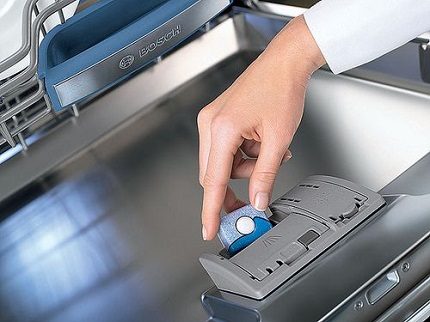
The work of dishwashers from different manufacturers can vary significantly, so the manufacturers of equipment draw up detailed instructions for the first launch. Do not ignore their recommendations, otherwise you may encounter unexpected problems during operation of the device.
The purpose of the dishwasher check
Before the first working inclusion, the dishwasher is tested without fail - they run one cycle without loading the dishes.
This check has several purposes:
- Cleaning. After manufacturing at the factory inside the parts of the new technique, traces of lubricants, small particles of garbage remain. While the car is in the store, they inspect it, touch it with their hands, which leads to the appearance of spots. A test run removes dirt and prepares the equipment for use.
- Functionality Check. During the first start-up, defects in the manufacture of the equipment appear. If it was damaged during transportation, this will also become apparent.
- Monitoring the correct installation and connection. In life, there is always a place for annoying accidents. Installers could make a mistake when installing, connecting to a water supply or sewage system. Sometimes they just forget to remove the shipping items. The test will reveal flaws.
- User training. Even if you bought not the first dishwasher, you still have to adapt to the new technology. Machines of various manufacturers have their own characteristics, and you need to deal with them before the device is put into operation.
For a test run, you will need a starter kit - detergent, salt and rinse aid. They either buy it separately specifically for checking the machine, or use the one that is planned to be used for washing dishes in the future. This will help determine the amount of salt, type of detergent.
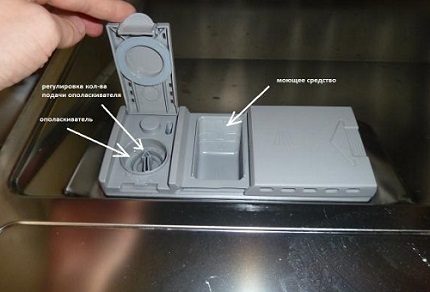
Sometimes users make a mistake: they run the first cycle without detergents, loading only salt. Thus, they are trying to save an extra pill or a dose of gel. Do not do this. Hot water will wash off technical grease, but traces of oily composition may remain under the gums.
Idling Procedure
First of all, the dishwasher is carefully inspected. You need to make sure that it is not damaged, and that there are no foreign objects in the chamber. Foam sealing inserts, stickers, etc. are sometimes forgotten inside the device. If everything is in order, you can turn on the machine in the network, unscrew the valve that blocks the water.

Then they act according to this scheme:
- Check if the machine is level.
- All inlet and outlet hoses must be securely connected and the joints tight. Make sure of it.
- Open the camera door. Check whether the sprayer rotates freely. To do this, you need to crank it several times.
- The drain filter is twisted, washed thoroughly with running water and household chemicals, and then installed in place.
- When choosing detergents, you need to find those that will not damage the machine parts. The required amount of salt and rinse aid is calculated immediately to set the program for the future.
- When all the preparatory work is completed, the machine is set to the longest washing mode without loading the basket. It is important that the temperature is as high as possible.
- It remains only to close the door tightly, start the dishwasher and monitor its work. If everything goes well, you do not need to intervene and try to improve something.
To regenerating salt it did not stick during the operation of the machine, about a liter of clean water was poured into an empty compartment.
Only after this procedure can it be filled. The recommended amount of liquid is 300-500 g.

If the dishwasher itself does not determine the chemistry, you need to manually enter the type of funds and the salt supply mode in the settings. Modern machines remember the entered parameters.
Aspects to Consider
While the dishwasher runs in test mode, the following functions need to be monitored:
- water supply - normally it arrives without fail, the car does not stop;
- heat - you should make sure that the heater is in order; it can not be checked in the store, so only a test run can detect problems;
- drain - water must flow out completely and without delay;
- drying - it is necessary to check whether moisture remains in the chamber after the end of the cycle.
If there are no complaints about the functionality of the dishwasher, it can be put into full operation. Do not load the dishes as soon as the machine has finished the test cycle. It should cool, so it's best to wait a couple of hours.
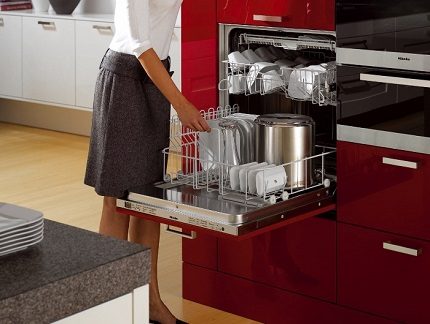
Sometimes a test run is trusted by a master who installed and connected the dishwasher. This makes sense if such a technique has never been in the house or there is cause for alarm regarding a particular model. Most often, anxiety is unfounded.
Start of operation - first operation
This stage is only begun after a test run of the PMM in idle mode. Otherwise, even if everything is in order with the equipment, traces of industrial grease may remain on clean dishes. These substances are potentially dangerous. It’s better not to save or risk your health.

Before starting operation, you will have to spend a little time and deal with pressing issues. You need to take care of the selection of detergents, preparations for preventive maintenance, learn how to load the basket correctly, find the optimal program for your cutlery.
We offer step-by-step instructions for preparing for the first start-up of the dishwasher in operating mode.
Step 1: selection of household chemicals
To ensure that the dishes are always clean, you need to decide on the best means for a particular model of machine.
You should focus on such criteria:
- Release form. There are powder, tablet, gel formulations. The quality of washing dishes and the cost-effectiveness of the product depend on the choice.
- Structure. Combined chemicals may contain several active ingredients. Each performs its function and is best suited to tasks of a certain type. You should choose depending on the type of dishes.
- Safety. Aggressive chemicals can be unhealthy. It’s better not to use some brands if the house has children, old people, pregnant women, allergies, asthmatics.
- Price. A dishwasher saves time and energy of the hostess, but this does not mean that you should go broke. It is necessary to determine the budget, which will be allocated monthly for household chemicals, and select the compounds that are suitable for the price.
Besides detergents, you will also need compositions for softening water, manual and automatic cleaning of the dishwasher, descaling from the walls of the chamber, heating elements and other parts of the machine.
Before buying detergents, you need to carefully read the composition on the package. Active substances are selected depending on the type of dishes available and the usual degree of contamination.
Aggressive products contain chlorine. They perfectly wash persistent pollution, remove stains from coffee, tea, herbal infusions. Another advantage is the pronounced whitening effect.
Chlorine-containing compounds are a good choice for dishes with durable coatings, but they are not suitable for delicate cutlery. They can not be used to wash silver, cupronickel, thin and fragile porcelain, crystal objects. If the dishes are hand-painted, it can be badly damaged in the car.
An alternative to chlorine is enzymes. These are slightly alkaline substances that gently wash all types of contaminants. They do not damage delicate surfaces; they work even in cold water. The downside is the lack of a whitening effect.
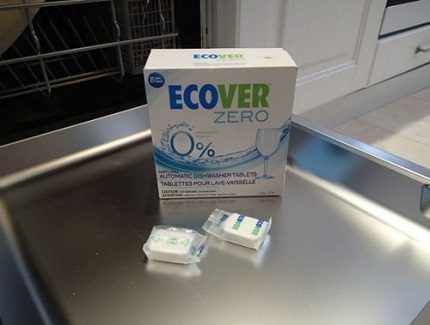
Families with young children, allergy sufferers, and asthmatics are better off buying detergents labeled “eco.” They do not contain aggressive chemicals, dyes and other hazardous substances.
Due to the natural composition, eco-friendly products do not cause allergic reactions or asthmatic attacks. The disadvantages include the dubious quality of washing dishes and traces of fat on the inside of the dishwasher. It will have to be cleaned more often from plaque.
Step 2: loading the basket correctly
The dishes are placed in the machine so that it does not interfere with the rotation of the sprinklers. Plates and pans should be completely washed with water. It is necessary that the liquid flows freely, otherwise subsequent drying will be difficult, and drops or stains will remain on the surfaces.
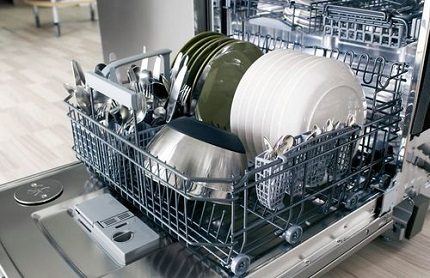
A few simple rules should be followed. loading dishwasher:
- The basket is loaded from the lower compartment. The largest and heaviest items are placed here.
- The top tray is for light dishes.Together with spoons, forks and knives, you can put lids on cans, bottles.
- If you need to wash a large pan for which there is not enough space, you can remove the upper tray.
- Between plates, bowls, pans, there must be space so that water can freely flow into each recess. To improve the quality of washing, you can tilt the dishes a little forward.
- If you want to wash a plastic salad bowl or container, it is placed in the upper tray. At the bottom of the machine is a heating element that can partially melt the material.
Before loading the dishes, you need to remove the remnants of food from it. In some cases, it makes sense to manually rinse heavily contaminated objects under running water. This is to prevent premature clogging of the filters.
We suggest that you familiarize yourself with the list of what is allowed to wash in a dishwasher and what is prohibited. A complete list of such items is provided in this article.
Visual aid for loading the dishwasher will help to carry out this part of the work competently:
Step 3: find the right program
In order for the dishes to be completely cleaned, you need to correctly set the program that determines the parameters washing cycle. All models have approximately the same options, but they are called differently. This can make it difficult to find the right regimen.

It’s worth looking into the standard features:
- Soak. The program is designed for two types of dishwashing - preliminary and main. It is worth choosing if the remnants of food have dried up on the plates or pans. Also, the mode is suitable for washing large amounts of fat, dough.
- High intensity washing. Heavily soiled dishes without burnt or dried food can be washed without soaking. In this case, the quality of cleaning is ensured by the high temperature of the water. The program is not suitable for delicate dishes with a delicate coating, plastic items.
- Standard mode. It allows you to get a good result with optimal energy consumption. The program is designed for utensils of moderate pollution.
- Economy mode. If cutlery is free of grease or dried food, it can be cleaned with a minimum of electricity and water.
- Delicate wash. Thin and delicate dishes need gentle care. The delicate mode is set for fragile services, porcelain, crystal.
- Quick wash. It’s just rinsing the dishes with household chemicals, and then clean water. The program does not provide for thorough cleaning of surfaces or drying.
For an idle test run, it is better to choose a high-intensity mode, and for the subsequent inclusion to find the optimal program.

It should be checked how the machine washed the first batch of dishes. If traces of dirt remain, you will have to adjust the mode or add detergent.
In the presence of stains on plates increase the amount of rinse aid.
Conclusions and useful video on the topic
New household appliances seem difficult to use, but this is only the beginning. As soon as you understand how it works, there will be no problems. To facilitate the first steps in the operation of the dishwasher, we suggest that you familiarize yourself with several thematic videos.
Testing and first launch of PMM:
The dishwasher will save the housewife from the need to soak, boil the dishes, scrape off the burnt food leftovers. You just need to make sure that the equipment is working, decide on the necessary functions and buy the right household chemicals.
Test the new appliance, adjust the settings and enjoy the rest, and entrust the unpleasant duties in the kitchen with a dishwasher.
Have experience connecting and starting up your dishwasher yourself? Or want to ask questions on the topic? Please comment on the publication and participate in the discussions. The feedback block is located below.

 Installing a Bosch dishwasher: how to properly install and connect a dishwasher
Installing a Bosch dishwasher: how to properly install and connect a dishwasher 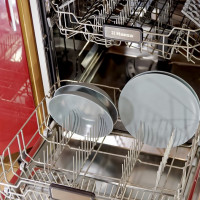 Hansa ZIM 476 H dishwasher overview: functional assistant for one year
Hansa ZIM 476 H dishwasher overview: functional assistant for one year 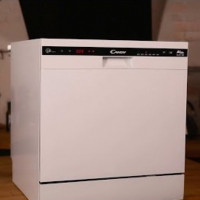 Candy CDCF 6E-07 dishwasher overview: is it worth buying a miniature
Candy CDCF 6E-07 dishwasher overview: is it worth buying a miniature 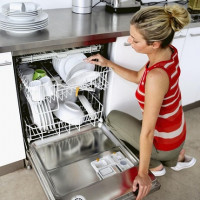 Which dishwasher detergent is better: high-performance detergent rating
Which dishwasher detergent is better: high-performance detergent rating 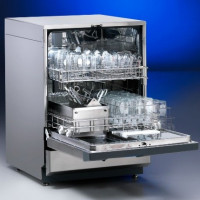 The principle of operation of a typical dishwasher: design, main components, operating rules
The principle of operation of a typical dishwasher: design, main components, operating rules 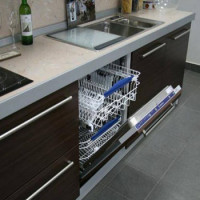 Overview of the Siemens SR64E002RU dishwasher: compactness is not a hindrance to functionality
Overview of the Siemens SR64E002RU dishwasher: compactness is not a hindrance to functionality  How much does it cost to connect gas to a private house: the price of organizing gas supply
How much does it cost to connect gas to a private house: the price of organizing gas supply  The best washing machines with dryer: model rating and customer tips
The best washing machines with dryer: model rating and customer tips  What is the color temperature of light and the nuances of choosing the temperature of the lamps to suit your needs
What is the color temperature of light and the nuances of choosing the temperature of the lamps to suit your needs  Replacement of a geyser in an apartment: replacement paperwork + basic norms and requirements
Replacement of a geyser in an apartment: replacement paperwork + basic norms and requirements
When we bought our dishwasher, we didn’t say anything about the first inclusion in the store, but I didn’t ask. Then she climbed into the network for useful information. It turned out that it needs to be driven away as well as an empty washer. Of course, the first time I didn’t wash the dishes, I thought that they took a bad dishwasher. But it turns out I just didn’t have everything right in the basket, now this is no longer there. Now I’m thinking how I used to live without her.
All this information - both about the first launch and about how to properly place the dishes in the machine, most likely is in the instructions for the dishwasher. Learn to read it and follow the recommendations, then all devices will work longer and cause you less problems.
Nothing of the kind, Eugene, in a very cheap Siemens dishwasher (model SR216W01MR) did not find a place in the instructions for even mentioning the first test start ...
Hello. This model of the dishwasher was a priori tested before launching the sale, as stated in the instruction manual. In addition, the manual describes in such detail all the nuances of connecting and installing that, in principle, with its perfect execution, a test start is needed only for the peace of mind of consumers.
Do I need to add salt when I start the dishwasher for the first time, if I use a 3 in 1 Calgonite tablet?
Good afternoon, Alice! At the first start of the dishwasher, water is poured into the salt container. At the second start salt is poured. Do I need to add salt if tablets are used? It all depends on the water hardness. To determine the hardness of water, you need to use test strips, which are necessarily supplied with PMM. Manufacturers of tablets on the packaging indicate to what extent their products can soften water. If the hardness of your water is much less, then salt can not be used. If the stiffness is greater, then it is necessary to fill in the salt.
Can't determine the hardness of the water? Then take no chances and use salt. If the water is soft, salt will simply not be consumed.
At the first start I didn’t use salt ... it was necessary to fill the container with water and salt ... how now to do it at the next use?
You can not worry about it. Fall asleep when you decide to wash with salt. Do not forget to change the salt dosage in the settings.